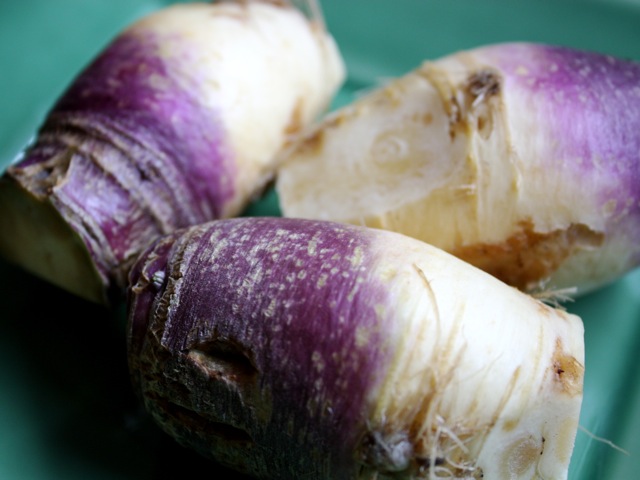
reference-image, l
(post, Caroline Cummins)
[%pageBreakSettings nobreak=true][%adInjectionSettings noInject=true] When you pull a rutabaga out of the ground, it looks a bit like the fabled Pacific Northwest Tree Octopus, all gnarly, feathery roots and floppy leaves. Topped and trimmed, however, it's just a plump root vegetable, cream-colored at the bottom and a blushing purple on the shoulders. [[block(sidebar). h1.Featured recipes]] At the store, it can be tricky to distinguish rutabagas from all the other bland-looking winter root vegetables — the turnips, parsnips, daikons, golden beets, and the like. And as a chat thread on Chowhound notes, rutabagas can have different regional names throughout North America and the Commonwealth. Spot the purple, though, and grab a few, because rutabagas have an unexpected flavor combination of sweet, delicate starch with an occasional bitter edge. (Note, however, that not all rutabagas have the purple half, and some turnips are purplish, too. Confusing!) [%image reference-image float=right width=400 caption="Young rutabagas, fresh from the garden, are less plump than the mature versions sold in stores."] Rutabagas are also known as swedes (from "Swedish turnip") or as yellow turnips; in Scotland, they're called neeps. They're not true turnips, however, as they're a cross between a cabbage and a turnip. Incidentally, the rutabaga was also a death word in my third-grade spelling bee, since none of us had ever heard of them. Now we know better; we even know that you can cook the rutabaga leaves, too, should you be lucky enough to find a market that sells them that way. Peel rutabagas before cooking, as the skins can be more bitter than the flesh, and some rutabagas sold in stores are waxed. (Bitterness turns up more often, too, in rutabagas exposed to too much sunlight or warmth while growing — another reason why they're tastier in winter.) Roast your swedes with other root veggies, such as carrots and golden beets, for a root bake. Want something softer? Peel, chop, steam, and mash them as you would ordinary potatoes, for a sunnier-looking swirl of starch. Or take a page from Mitchell Davis' Kitchen Sense and combine multiple flavors with mashing, for a mixed-vegetable mash. Deborah Madison uses the same multi-veg idea for her Winter Vegetable Chowder. Christopher Hirsheimer and Melissa Hamilton, the ladies behind Canal House Cooking, note in Volume 2 of their cookbooks that they often add a starchy potato to a rutabaga mash, as rutabagas can be "quite watery." And Emily Franklin notes in Too Many Cooks that rutabagas are traditional filler in Cornish Pasties.

reference-image, l